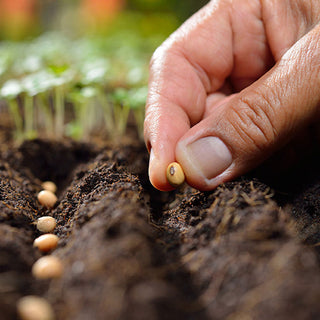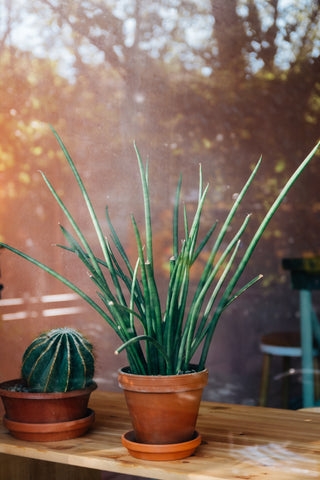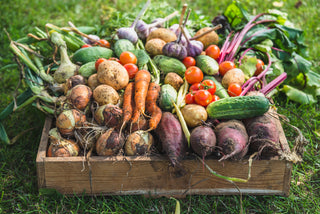PLEASE NOTE: ALL INDOOR PLANTS & TREES ARE ONLY AVAILABLE FOR CLICK & COLLECT FROM WERRIBEE SOUTH FARMGATE OR LOCAL DELIVERY* Please see our local delivery areas here.
Olea europaea 'Kalamata,' commonly known as the Kalamata olive tree, is a delightful and sought-after cultivar that originates from Greece. It is a small to medium-sized evergreen tree with a compact, rounded canopy. The Kalamata olive tree is beloved for its exceptional fruit, which is renowned worldwide for its distinctive taste and culinary versatility.
Foliage:
The leaves of the Kalamata olive tree are lance-shaped and leathery, featuring a rich, dark green color that adds an elegant touch to any landscape. These glossy leaves create a lush canopy that stays vibrant throughout the year, making the tree an attractive addition to gardens and outdoor spaces.
Fruit:
The true star of the Kalamata olive tree is its fruit. The olives are strikingly beautiful, displaying an elongated and almond-like shape. They mature to a deep, purple-black hue when fully ripe, making them easily identifiable. These olives are famous for their meaty and rich flavor, often described as slightly sweet and tangy with a hint of bitterness.
Culinary Uses:
The Kalamata olives are highly prized for their culinary applications, particularly in Mediterranean cuisine. They are a staple in Greek salads, served as table olives, and frequently used to produce high-quality olive oil. Their unique taste and texture add a delightful touch to a wide range of dishes, from pizzas and pastas to tapenades and antipasto platters.
Growing Requirements:
As a Mediterranean native, the Kalamata olive tree thrives in climates with long, hot summers and mild winters. It requires a sunny location with well-draining soil to flourish. Once established, it is remarkably drought-tolerant and resilient, making it an excellent choice for gardeners seeking low-maintenance trees.
Ornamental Appeal:
Beyond its culinary value, the Kalamata olive tree also possesses ornamental appeal. Its attractive, evergreen foliage and intriguing fruit make it an eye-catching feature in gardens, patios, and even larger containers. When not cultivated for fruit production, it can be pruned into a graceful, small tree suitable for various landscaping styles.
Planting Guide for Kalamata and Manzanillo Olive Trees in Australia:
Olive trees (Olea europaea) are well-suited to the Mediterranean-like climate of many regions in Australia. Here's a comprehensive planting guide specifically for the Kalamata and Manzanillo varieties:
Selecting Olive Varieties:
Choose the Kalamata and Manzanillo olive tree varieties, as they are known to perform well in Australian climates. The Kalamata variety is renowned for its dark purple, almond-shaped fruits, while the Manzanillo variety produces green olives that are excellent for curing and table use.
Site Selection:
Choose a sunny location in Australia with at least 6-8 hours of sunlight per day.
Olive trees prefer warm and sheltered positions to protect them from strong winds and frost. Select a spot with well-draining soil to prevent waterlogging.
Soil Preparation:
Olive trees thrive in well-draining soil with a pH between 6.0 and 8.5.
If the soil is heavy and poorly draining, consider creating raised beds or mounds for planting.
Incorporate organic matter, such as compost, into the soil to improve fertility and structure.
Planting Time:
The best time to plant olive trees in Australia is during the cooler months of autumn or spring when the soil is still warm.
Planting Process:
Dig a hole twice as wide and deep as the root ball of the olive tree.
Carefully remove the tree from its container, ensuring minimal disturbance to the roots.
Place the tree in the hole, ensuring the soil level matches the top of the root ball.
Fill the hole with soil and gently compact it to eliminate air pockets.
Water the tree thoroughly after planting to help establish the root system.
Watering:
While olive trees are drought-tolerant, regular watering during the first year is crucial to aid establishment.
Water deeply and less frequently to encourage deep root growth.
Once established, reduce watering to mimic natural rainfall patterns.
Mulching:
Apply a layer of organic mulch around the base of the tree, but avoid piling it against the trunk.
Mulching helps retain soil moisture, suppress weeds, and regulate soil temperature.
Fertilisation:
Olive trees have low nutrient requirements. Apply a balanced fertiliser, specifically formulated for fruit trees, in early spring and late summer.
Avoid excessive nitrogen fertilisers, as they can lead to excessive vegetative growth and reduced fruiting.
Pruning:
Prune olive trees during late winter or early spring to remove dead, diseased, or crowded branches.
Olive trees have a natural tendency to develop an open canopy, so encourage this shape to improve sunlight penetration and airflow.
Pest and Disease Management:
Monitor for common pests such as olive fruit fly and scale insects.
Implement appropriate pest control measures if necessary, and consider using natural predators for organic pest management.
Remember that specific growing conditions can vary between different regions in Australia. It's advisable to consult with local horticultural experts or agricultural extension offices for region-specific advice. Happy olive tree planting!
We are a proudly Australian-owned family business dedicated to providing high-quality seedlings, seeds, fruit trees, native plants, and indoor ornamentals. We offer express shipping to SA, VIC, QLD, and NSW, with local delivery and pickups available by arrangement. Unfortunately, due to restrictions, we are unable to send to TAS, WA, or NT. For OH&S and biosecurity reasons, farm tours and direct purchases are not available, and pickups can only be made at our farm gate entrance. We deeply value our loyal customers and thank you for your continued support.
Adding product to your cart
You may also like
PLEASE NOTE: ALL INDOOR PLANTS & TREES ARE ONLY AVAILABLE FOR CLICK & COLLECT FROM WERRIBEE SOUTH FARMGATE OR LOCAL DELIVERY* Please see our local delivery areas here.
Olea europaea 'Kalamata,' commonly known as the Kalamata olive tree, is a delightful and sought-after cultivar that originates from Greece. It is a small to medium-sized evergreen tree with a compact, rounded canopy. The Kalamata olive tree is beloved for its exceptional fruit, which is renowned worldwide for its distinctive taste and culinary versatility.
Foliage:
The leaves of the Kalamata olive tree are lance-shaped and leathery, featuring a rich, dark green color that adds an elegant touch to any landscape. These glossy leaves create a lush canopy that stays vibrant throughout the year, making the tree an attractive addition to gardens and outdoor spaces.
Fruit:
The true star of the Kalamata olive tree is its fruit. The olives are strikingly beautiful, displaying an elongated and almond-like shape. They mature to a deep, purple-black hue when fully ripe, making them easily identifiable. These olives are famous for their meaty and rich flavor, often described as slightly sweet and tangy with a hint of bitterness.
Culinary Uses:
The Kalamata olives are highly prized for their culinary applications, particularly in Mediterranean cuisine. They are a staple in Greek salads, served as table olives, and frequently used to produce high-quality olive oil. Their unique taste and texture add a delightful touch to a wide range of dishes, from pizzas and pastas to tapenades and antipasto platters.
Growing Requirements:
As a Mediterranean native, the Kalamata olive tree thrives in climates with long, hot summers and mild winters. It requires a sunny location with well-draining soil to flourish. Once established, it is remarkably drought-tolerant and resilient, making it an excellent choice for gardeners seeking low-maintenance trees.
Ornamental Appeal:
Beyond its culinary value, the Kalamata olive tree also possesses ornamental appeal. Its attractive, evergreen foliage and intriguing fruit make it an eye-catching feature in gardens, patios, and even larger containers. When not cultivated for fruit production, it can be pruned into a graceful, small tree suitable for various landscaping styles.
Planting Guide for Kalamata and Manzanillo Olive Trees in Australia:
Olive trees (Olea europaea) are well-suited to the Mediterranean-like climate of many regions in Australia. Here's a comprehensive planting guide specifically for the Kalamata and Manzanillo varieties:
Selecting Olive Varieties:
Choose the Kalamata and Manzanillo olive tree varieties, as they are known to perform well in Australian climates. The Kalamata variety is renowned for its dark purple, almond-shaped fruits, while the Manzanillo variety produces green olives that are excellent for curing and table use.
Site Selection:
Choose a sunny location in Australia with at least 6-8 hours of sunlight per day.
Olive trees prefer warm and sheltered positions to protect them from strong winds and frost. Select a spot with well-draining soil to prevent waterlogging.
Soil Preparation:
Olive trees thrive in well-draining soil with a pH between 6.0 and 8.5.
If the soil is heavy and poorly draining, consider creating raised beds or mounds for planting.
Incorporate organic matter, such as compost, into the soil to improve fertility and structure.
Planting Time:
The best time to plant olive trees in Australia is during the cooler months of autumn or spring when the soil is still warm.
Planting Process:
Dig a hole twice as wide and deep as the root ball of the olive tree.
Carefully remove the tree from its container, ensuring minimal disturbance to the roots.
Place the tree in the hole, ensuring the soil level matches the top of the root ball.
Fill the hole with soil and gently compact it to eliminate air pockets.
Water the tree thoroughly after planting to help establish the root system.
Watering:
While olive trees are drought-tolerant, regular watering during the first year is crucial to aid establishment.
Water deeply and less frequently to encourage deep root growth.
Once established, reduce watering to mimic natural rainfall patterns.
Mulching:
Apply a layer of organic mulch around the base of the tree, but avoid piling it against the trunk.
Mulching helps retain soil moisture, suppress weeds, and regulate soil temperature.
Fertilisation:
Olive trees have low nutrient requirements. Apply a balanced fertiliser, specifically formulated for fruit trees, in early spring and late summer.
Avoid excessive nitrogen fertilisers, as they can lead to excessive vegetative growth and reduced fruiting.
Pruning:
Prune olive trees during late winter or early spring to remove dead, diseased, or crowded branches.
Olive trees have a natural tendency to develop an open canopy, so encourage this shape to improve sunlight penetration and airflow.
Pest and Disease Management:
Monitor for common pests such as olive fruit fly and scale insects.
Implement appropriate pest control measures if necessary, and consider using natural predators for organic pest management.
Remember that specific growing conditions can vary between different regions in Australia. It's advisable to consult with local horticultural experts or agricultural extension offices for region-specific advice. Happy olive tree planting!
We are a proudly Australian-owned family business dedicated to providing high-quality seedlings, seeds, fruit trees, native plants, and indoor ornamentals. We offer express shipping to SA, VIC, QLD, and NSW, with local delivery and pickups available by arrangement. Unfortunately, due to restrictions, we are unable to send to TAS, WA, or NT. For OH&S and biosecurity reasons, farm tours and direct purchases are not available, and pickups can only be made at our farm gate entrance. We deeply value our loyal customers and thank you for your continued support.
You may also like
You may also like

CERTIFIED ORGANIC
Commercial-grade certified organic seed boasts top-notch germination rates and yields, perfect for Aussie growers
Testimonials

QPS offers a wide selection of high-quality seedlings, including herbs, vegetables, and ornamental plants. They are known for their robust health and diverse variety, catering to all gardening preferences. With careful packaging and clear care instructions, Quality plants & seedlings ensures their plants arrive in good condition. They prioritise customer service and sustainability, making them a trusted choice for gardeners of all levels aiming to create thriving gardens.

Choosing QPS for my certified organic seeds was a game-changer for my garden. The variety of herbs, vegetables, and ornamental plants available exceeded my expectations, all grown with meticulous organic practices. The seeds arrived promptly and were clearly labeled with planting instructions, making the process smooth and stress-free. I've been impressed with the high germination rates and the healthy growth of the plants, reflecting QPS's commitment to quality. For anyone looking to start or expand an organic garden, QPS is my go-to choice for reliable, sustainable seeds.

Sourcing wholesale indoor plants from QPS has been a fantastic experience for my projects as a landscape designer. Their extensive selection of indoor plants is of exceptional quality, perfect for creating vibrant interior spaces. Each plant arrives well-packaged and in excellent condition, reflecting QPS's attention to detail and commitment to customer satisfaction. Their competitive wholesale pricing makes them a preferred supplier for large-scale projects. I highly recommend Quality Plants & Seedlings to fellow professionals and enthusiasts seeking reliable, top-notch indoor plants for their designs.

Choosing QPS for seedlings at our school has been a great decision. Their diverse range includes everything from vegetables to ornamental plants, all nurtured with care using organic practices. The seedlings arrived promptly and were well-packaged with clear instructions, making them easy for students to handle and plant. We've been pleased with the robust health and rapid growth of the plants, which has enhanced our educational gardening initiatives. QPS's commitment to quality and sustainability makes them an ideal choice for schools looking to cultivate a green thumb in students.
Recommended products


By completing this form, you are signing up to receive our emails and can unsubscribe at any time.
We offer express postage straight to your door, servicing SA, VIC, NSW, and QLD. Click & Collect is also available—please note, no walk-ins allowed.
Our seedlings ensure seamless transplanting with minimal crop stress for optimal growth and yield.
Our Australian customers trust us for seedlings that deliver high yields and strong root growth, proven by their loyalty and repeat purchases.
We are PCI compliant by default so you can keep payment info and business data safe.




